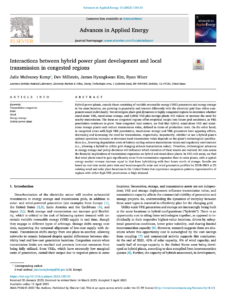Full Title: Interactions Between Hybrid Power Plant Development and Local Transmission in Congested Regions
Author(s): Julie Mulvaney Kemp, Dev Millstein, James Hyungkwan Kim, Ryan H Wiser
Publisher(s): Advances in Applied Energy
Publication Date: April 11, 2023
Full Text: Download Resource
Description (excerpt):
Hybrid power plants, namely those consisting of variable renewable energy (VRE) generators and energy storage in the same location, are growing in popularity and interact differently with the electrical grid than either component would individually. We investigate plant-grid dynamics in highly congested regions to determine whether stand-alone VRE, stand-alone storage, and hybrid VRE-plus-storage plants will reduce or increase the need for nearby transmission. The focus on congested regions offers empirical insight into future grid conditions, as VRE penetration continues to grow. Near congested load centers, we find that hybrid, stand-alone VRE and stand-alone storage plants each reduce transmission value, defined in terms of production costs. On the other hand, in congested areas with high VRE penetration, stand-alone storage and VRE generators have opposing effects, decreasing and increasing the need for transmission, respectively. Importantly, whether or not a hybrid plant’s optimal operation increases or decreases local transmission value depends on the plant’s technological specifications (i.e., lowering degradation costs of battery cycling reduces transmission value) and regulatory environment (i.e., allowing a hybrid to utilize grid charging reduces transmission value). Therefore, technological advances in energy storage and policy decisions will influence which variation of these results are realized. We also assess the financial implications of transmission expansion on hybrid and stand-alone plants. In VRE-rich areas, we find that wind plants stand to gain significantly more from transmission expansion than do solar plants, with a typical energy market revenue increase equal to that from hybridizing with four hours worth of storage. Results are based on real-time nodal price data and location-specific solar and wind generation profiles for 2018–2021 at 23 existing wind and solar plant locations in the United States that experience congestion patterns representative of regions with either high VRE penetration or high demand.
